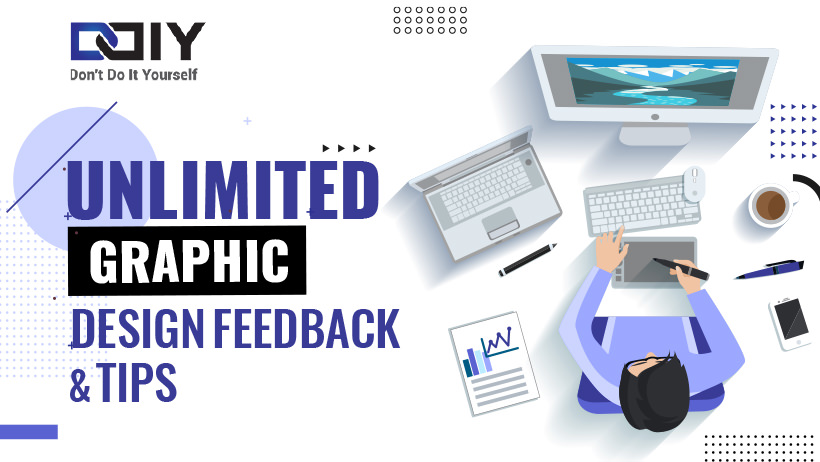How To Give Better Graphic Design Feedback
Author: Stefan Schulz, digital agency owner, and Kimp partner.

Working with a graphic designer is an exciting endeavor. They provide the resources, experience, and skills to help bring creative visions to life. But the process of getting to that final product isn’t always smooth. Especially in the early “getting to know each other” stages.
Once you take the checkbook out and start paying someone for a product or service, expectations rise. Graphic design is no exception. However, it’s important to understand that with graphic design, you’re not typically paying for a ready-made product. You’re paying someone for a service to develop a product for you. This isn’t something you just grab off the shelf and take home with you.
So how do you get what you’re looking for?
To get exactly what you’re looking for, you’re going to need to be involved from start to finish. Sure, there will be times when you submit a rock-solid creative brief and your graphic designer knocks it out of the park on the first try.
That’s a luxury though. I’ve worked as a project manager on thousands of graphic design projects over my career. I’d estimate less than 2% of those projects are complete after the first round of concepts are provided.
Unless you are the world’s greatest brief developer, or just someone that has luck like Frane Selak, you’ll find yourself in a position where on-going communication is required. And one of the most critical components to a positive working graphic design relationship is client feedback.
Yes, that’s right, feedback. How inconvenient — the horror!
The idea of having to provide feedback just sounds annoying, doesn’t it?
“Ugh, can’t they just figure it out? I’m busy.”
As much as we’d like to just open the walls to our skulls and let our graphic designers into our head, we can’t. Hurry up Elon Musk, we’re waiting.
So, until the day comes where telepathic graphic design is mainstream, we’ll need to settle for providing quality feedback. To do so, it’s important to understand some of the common graphic design feedback problems. Below I’ll outline some challenges that I’ve faced myself as a creative commander. In addition, I’ll present my primary solution to overcome my feedback phobias, which have enabled me to maximize my unlimited graphic design resources every month.
The problems that prevent us from providing better graphic design feedback
Hating the designs entirely
Ever walk into a museum, an art gallery, or even your grandmother’s house, look at a painting on the wall, and throw up in your mouth a little? I know I have.
We can’t help what we like and don’t like sometimes. Taste is subjective. There are going to be times when you get design work back and you’re just going to hate everything about them. The font. The colors. The choice of visual elements. They layout. Everything. It’s really difficult to provide graphic design feedback when you personally just don’t like something. It’s even more difficult when you hate everything about it.
Not wanting to offend your designer
This is a problem that often immediately follows up after you’ve received designs that just simply missed the mark. After you’ve gotten that foul, pukey taste out of your mouth, and the dust starts to settle, you realize that you have to say something.
And unless you’re just addicted to confrontation, or get kicks out of making people feel crappy about themselves, you probably want to take it easy on your designer. After all, they didn’t intend to give you something you don’t like. Their goal was to make you happy. And in their eyes, at that precise time when they either hit submit or send, they felt like they did a good job.
We subconsciously know that there’s another human involved here. So, oftentimes, in effort not to offend our graphic designers, we say something “too nice”. We sugarcoat how we’re really feeling. This is counterintuitive and arguably more unproductive than being a jerk because it could lead to an infinite number of iterations.
Insufficient time and resources
“There just aren’t enough hours in the day.” This holds true for many things beyond graphic design. Yesterday, I didn’t make breakfast. Forgot to take that load of laundry out of the washer. Wasn’t able to call my parents. I stashed a few-half-a-dozen emails into a folder for follow ups. The list of things that I didn’t get to goes on and on.
Sitting down for fifteen minutes to binge-watch poorly produced Tik Tok videos was just enough to digitally detox, so I could maintain my sanity and get back into the rat race this morning. That’s probably not healthy, but oh well, I’m pretty sure it’s as normal as normal gets.
Many people are pressed for time. We are struggling to find balance between personal and professional events. Getting that 30-minute window to physically sit down and stare at designs that we expected to be done already isn’t always easy.
Not knowing what to look for
I’m a graphic design aficionado. I used to do a ton of graphic design myself. I know what to look for. But many people that are delegating out graphic design projects, aren’t designers themselves. They could be entrepreneurs, accountants, attorneys, construction developers, doctors, hospitality specialists, politicians, the list goes on and on…
So, who are you to say what’s good and what’s not? “You’re the graphic designer, you tell me,” can be a dangerous game to play. When you don’t know what to look for, you often delegate what to look for to the designer. This is a problem for a few reasons. For one, not all graphic designers have a clear understanding of your business or goals. They’re good at designing. But do they understand what makes your target audience tick?
On top of that, you’re putting all of your eggs in one basket. When you don’t know what to look for and delegate back to the designer, the subjectivity of the designer starts to come into play. This narrows your focus, making it appealing to an individual rather than the masses.
Ownership bias
A natural human flaw is the ego. We often get wrapped up in our own personal identities and outwardly project opinions to build ourselves up. We fall in love with using the word “I”.
I know what’s best for my business. I don’t like that design. And I think those fonts are ugly!
This type of thinking can be appropriate at times to provide direction, but it can also be harmful in creating a quality design that generates results in the marketplace. Your experience and vision is important. But unless you’re paying a graphic designer to stroke your own ego, and not to get other people to act, your opinion is really irrelevant.
The solution: sourced graphic design feedback from social media channels
A couple of years ago I had a client that absolutely loved their logo. To put it bluntly, their logo design was atrocious. It looked like it was created in Paint, so I worked with my graphic design team to put together what “I” thought were better options based on my professional experience. They didn’t budge. Basically, we were in a stalemate.
I couldn’t let them self-sabotage, so I got an idea to post all of the logos on Facebook and poll friends, family, colleagues, and complete strangers in a handful of groups. The idea was to let the market do the work for me. Don’t take my word for it. Take the word of hundreds of strangers (a.ka. potential consumers for your business).
My ego was thankful that I ran this experiment because it essentially proved that I was right. People hated their crayon-stained dumpster fire of a logo and loved one of the professional designs that we created. I was excited about the win so we could move forward, but was more intrigued about how people rallied to get behind the designs.
The power of good feedback
The feedback we received was very well articulated. Sure, some of it was basic reaffirmations like, “Go with number 3!” But other responses brought up issues, concerns, and suggestions that we would have never thought of.
Asking for graphic design feedback from a community is one of the smartest, impactful, and cost-effective things you can do. It takes less than five minutes. Provides a multitude of different perspectives. And takes the weight off of your shoulders, making it easier for you to go back to your graphic designer to make changes.
I love being able to say this to my graphic designer: “Hey Mary, thanks for the first round of concepts. We circled them around in our group and got the below feedback…” Copy and paste actual screenshots of feedback. P.S. Don’t shoot the messenger!
Get better graphic design feedback on Facebook
Stuck on a design? Want to provide better feedback to your graphic design team? Join us in Unlimited Graphic Design Feedback & Tips Group on Facebook. This is a private community of people passionate about unlimited graphic design as a service. Feel free to post your design projects and collect expert feedback and tips from digital marketers, graphic designers, entrepreneurs, and other industry experts.

